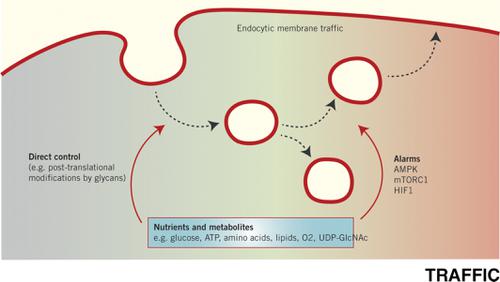Our official English website, www.x-mol.net, welcomes your feedback! (Note: you will need to create a separate account there.)
Energetic adaptations: Metabolic control of endocytic membrane traffic.
Traffic ( IF 4.5 ) Pub Date : 2019-11-15 , DOI: 10.1111/tra.12705 Sadia Rahmani 1 , Marina S Defferrari 1 , Warren W Wakarchuk 1, 2 , Costin N Antonescu 1, 3
Traffic ( IF 4.5 ) Pub Date : 2019-11-15 , DOI: 10.1111/tra.12705 Sadia Rahmani 1 , Marina S Defferrari 1 , Warren W Wakarchuk 1, 2 , Costin N Antonescu 1, 3
Affiliation

|
Endocytic membrane traffic controls the access of myriad cell surface proteins to the extracellular milieu, and thus gates nutrient uptake, ion homeostasis, signaling, adhesion and migration. Coordination of the regulation of endocytic membrane traffic with a cell's metabolic needs represents an important facet of maintenance of homeostasis under variable conditions of nutrient availability and metabolic demand. Many studies have revealed intimate regulation of endocytic membrane traffic by metabolic cues, from the specific control of certain receptors or transporters, to broader adaptation or remodeling of the endocytic membrane network. We examine how metabolic sensors such as AMP-activated protein kinase, mechanistic target of rapamycin complex 1 and hypoxia inducible factor 1 determine sufficiency of various metabolites, and in turn modulate cellular functions that includes control of endocytic membrane traffic. We also examine how certain metabolites can directly control endocytic traffic proteins, such as the regulation of specific protein glycosylation by limiting levels of uridine diphosphate N-acetylglucosamine (UDP-GlcNAc) produced by the hexosamine biosynthetic pathway. From these ideas emerge a growing appreciation that endocytic membrane traffic is orchestrated by many intrinsic signals derived from cell metabolism, allowing alignment of the functions of cell surface proteins with cellular metabolic requirements. Endocytic membrane traffic determines how cells interact with their environment, thus defining many aspects of nutrient uptake and energy consumption. We examine how intrinsic signals that reflect metabolic status of a cell regulate endocytic traffic of specific proteins, and, in some cases, exert broad control of endocytic membrane traffic phenomena. Hence, endocytic traffic is versatile and adaptable and can be modulated to meet the changing metabolic requirements of a cell.
中文翻译:

能量适应:内吞膜运输的代谢控制。
内吞膜运输控制无数细胞表面蛋白进入细胞外环境,从而控制养分吸收,离子稳态,信号传递,粘附和迁移。内吞膜运输的调节与细胞的代谢需求的协调代表了在营养物可利用和代谢需求的可变条件下维持体内平衡的重要方面。许多研究表明,通过代谢线索对内吞膜运输的密切调节,从某些受体或转运蛋白的特异性控制,到内吞膜网络的更广泛适应或重塑。我们研究了诸如AMP激活的蛋白激酶,雷帕霉素复合物1的机械靶标和缺氧诱导因子1等代谢传感器如何确定各种代谢物的充足性,进而调节细胞功能,包括控制内吞膜运输。我们还研究了某些代谢物如何直接控制内吞运输蛋白,例如通过限制己糖胺生物合成途径产生的尿苷二磷酸N-乙酰氨基葡萄糖(UDP-GlcNAc)的水平来调节特定的蛋白质糖基化。从这些想法中,人们逐渐认识到,内吞膜的运输是由细胞代谢产生的许多内在信号精心策划的,从而使细胞表面蛋白的功能与细胞代谢的需要保持一致。内吞膜运输决定了细胞与环境的相互作用,从而定义了养分吸收和能量消耗的许多方面。我们研究了反映细胞代谢状态的内在信号如何调节特定蛋白的内吞运输,并在某些情况下对内吞膜运输现象进行广泛控制。因此,胞吞运输是通用的和可适应的,并且可以被调节以满足细胞不断变化的代谢需求。
更新日期:2019-11-15
中文翻译:

能量适应:内吞膜运输的代谢控制。
内吞膜运输控制无数细胞表面蛋白进入细胞外环境,从而控制养分吸收,离子稳态,信号传递,粘附和迁移。内吞膜运输的调节与细胞的代谢需求的协调代表了在营养物可利用和代谢需求的可变条件下维持体内平衡的重要方面。许多研究表明,通过代谢线索对内吞膜运输的密切调节,从某些受体或转运蛋白的特异性控制,到内吞膜网络的更广泛适应或重塑。我们研究了诸如AMP激活的蛋白激酶,雷帕霉素复合物1的机械靶标和缺氧诱导因子1等代谢传感器如何确定各种代谢物的充足性,进而调节细胞功能,包括控制内吞膜运输。我们还研究了某些代谢物如何直接控制内吞运输蛋白,例如通过限制己糖胺生物合成途径产生的尿苷二磷酸N-乙酰氨基葡萄糖(UDP-GlcNAc)的水平来调节特定的蛋白质糖基化。从这些想法中,人们逐渐认识到,内吞膜的运输是由细胞代谢产生的许多内在信号精心策划的,从而使细胞表面蛋白的功能与细胞代谢的需要保持一致。内吞膜运输决定了细胞与环境的相互作用,从而定义了养分吸收和能量消耗的许多方面。我们研究了反映细胞代谢状态的内在信号如何调节特定蛋白的内吞运输,并在某些情况下对内吞膜运输现象进行广泛控制。因此,胞吞运输是通用的和可适应的,并且可以被调节以满足细胞不断变化的代谢需求。


























 京公网安备 11010802027423号
京公网安备 11010802027423号